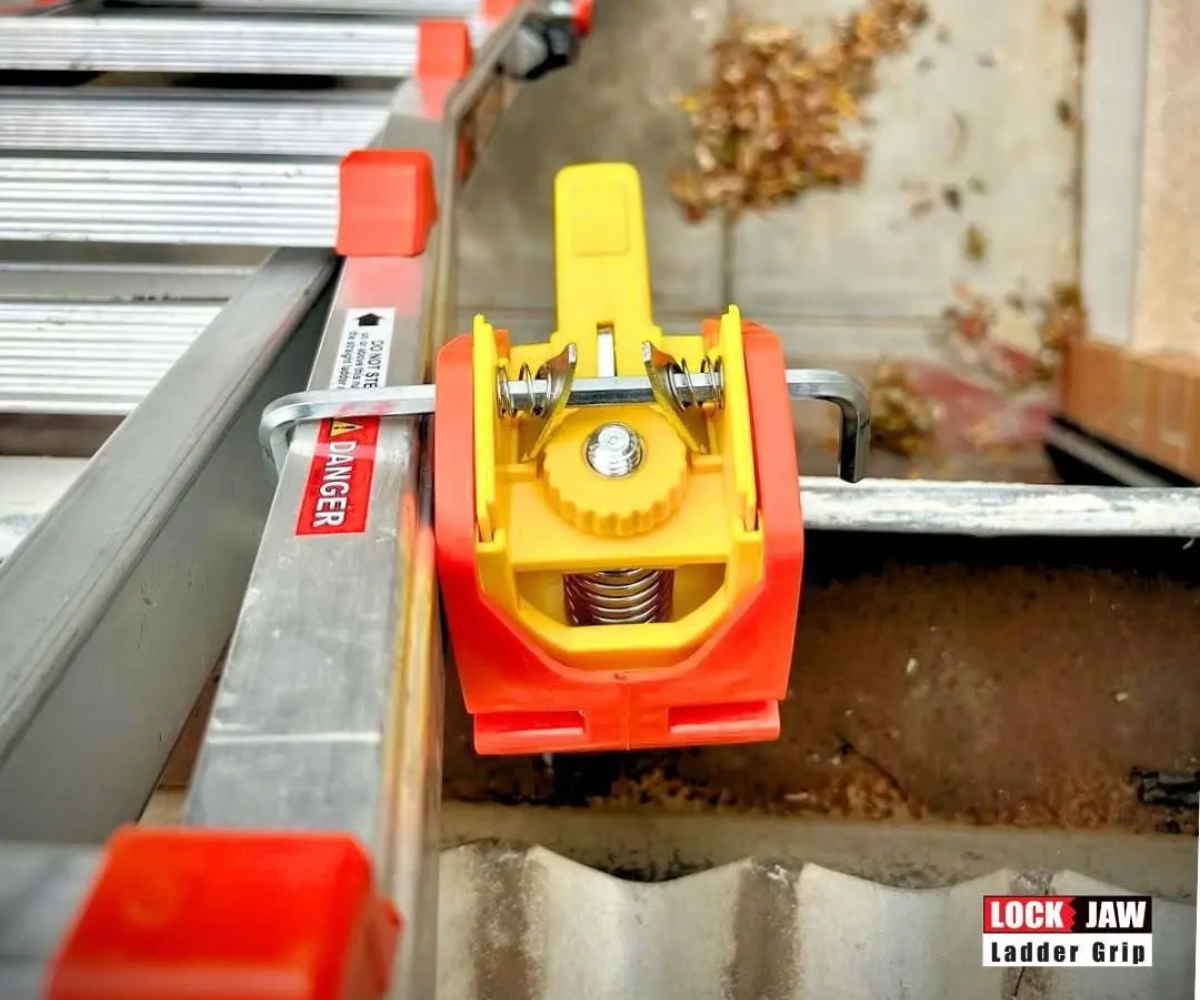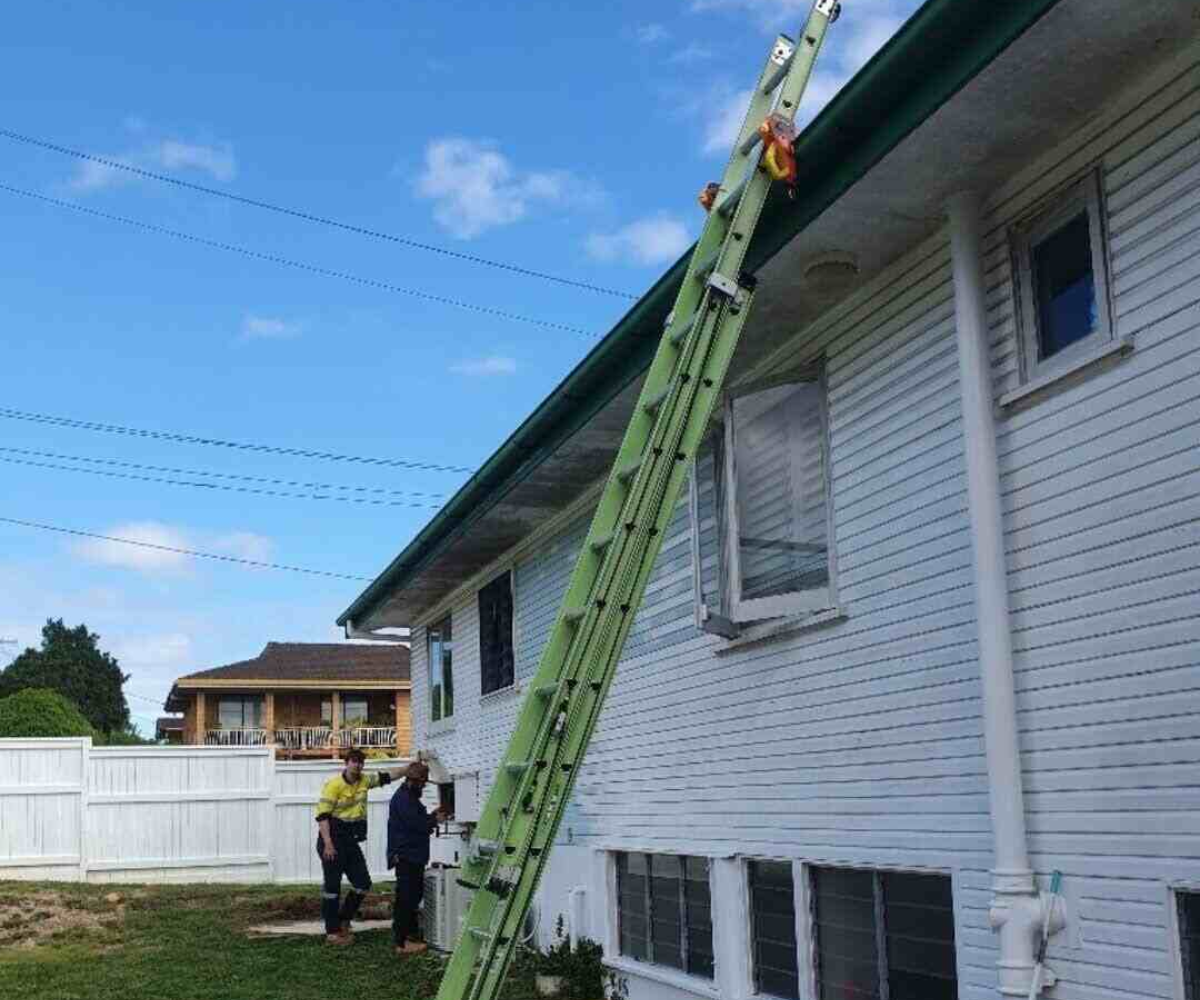Maximize Safety with the Top Extension Ladder stabilizer Choices

Are you wondering how to enhance your extension ladder’s safety? Discover the essential role of ladder stabilizers. This article covers the ins and outs of different stabilizers, details on their effectiveness for safe access at elevations, and tips to help you make the best selection for your tasks
Key Takeaways
- The Lock Jaw Ladder Grip is an innovative ladder safety product, and a highly regarded stabilization accessory for extension ladders, praised for its quick engagement, versatility, and effectiveness in enhancing safety.
- A variety of accessories such as standoff stabilizers, ladder mitts, leg levelers, and stability bars are available to improve the stability and safety of extension ladders on different surfaces and terrains.
- Selecting the right ladder stabilizer device involves considering the combined weight capacity, compatibility with ladder models, and adherence to safety standards, as well as routine inspections and maintenance for optimal safety.
Lock Jaw Ladder Grip: A Revolutionary Ladder Safety Solution

The Lock Jaw Ladder Grip is valued for its:
Simplicity
Reliability
Ease of use
Adaptability
Effectiveness
It’s versatile for different work environments, making it a game-changer in the realm of ladder accessories.
Its revolutionary design and function have been recognised with finalist status in the prestigious Shell Australian Innovation Awards. This innovative ladder safety product is a testament to its unique ability to enhance the safety and stability of extension ladders, cementing its position as a key player in ladder safety.
Features and Benefits
The Lock Jaw Ladder Grip stands out with its robust design, featuring:
A patented jaw and retention mechanism that prevents ladder movement
Constructed from high-quality nylon and steel, making it durable
Rubber grips to minimize damage to surfaces such as gutters
These features make it a flexible and valuable addition to any safety toolkit, enhancing the effectiveness of your device and keeping you safe.
Further, the convenience of the stabilizer is underscored by its many features, one being its quick engagement time—locking onto ladders in about 5 seconds—and its wide ladder compatibility. Backed by a 30-day money-back guarantee, it has gained the trust of customers and continues to make a significant contribution to ladder safety.
Installation and Usage
The Lock Jaw Ladder Grip is designed for ease and convenience. It can be installed and removed in just seconds, making it an efficient choice for quick setups no matter the length of your ladder. It features a built-in carabiner for easy climbing, freeing your hands and ensuring user-friendly operation even for first-time users.
Furthermore, its one-handed operation allows for efficient manipulation while securing or releasing the ladder. This means you can focus more on your task at hand, with the assurance that your ladder is secure.
Versatile Ladder Accessories for Enhanced Stability
Additional ladder accessories can add an extra layer of safety and stability features to extension ladder use. These include items like stand-off stabilizers, ladder mitts, and leg levelers, each designed to address specific safety concerns and stability issues.
Some ladder accessories that can enhance safety and functionality include:
- Standoff stabilizer: keeps the ladder a safe distance from walls or windows, which is helpful for tasks like window cleaning or house painting.
- Ladder mitts: used to prevent damage to support surfaces, such as delicate siding or paintwork.
- Leg levelers: can adapt a ladder to uneven ground, creating a stable, level base for safety.
These accessories are often universally compatible with different brands or types of ladders, being flexible for users with various ladder models.
Stability Bars
Stability is a crucial aspect when working with ladders, especially for ladders over 3 meters high. Ladder regulations mandate these ladders to have a wider base for enhanced stability and safety, typically provided by a stability bar.
These bars attach to the ladder to widen the base, which significantly improves balance and reduces the risk of tipping. This simple yet effective accessory can ensure access to a safer working environment.
Ladder Levelers
Ladder levelers are innovative ladder safety products that enhance stability and safety by adjusting to compensate for uneven ground. They prevent ladder tilt and provide a balanced base, making them an excellent solution for challenging terrains.
These levelers are straightforward to use:
- They lock securely into place once the ladder achieves stability, allowing for safe use.
- They broaden the scope of DIY projects, enabling ladder use on uneven terrain.
- They offer non-slip grips for enhanced safety.
As cost-effective accessories, they are a valuable addition to any ladder.

When selecting a ladder stabilizer, it’s important to consider the combined weight of the user and any carried tools or materials. This ensures the stabilizer supports the total load, maximizing safety and efficiency in use.
Compatibility is another crucial factor. Ensure the chosen ladder stabilizer is compatible with the ladder makes and models in use, and that it meets safety standards. This step ensures you get the most out of your safety equipment investment and pick a tool that will properly keep your ladder in position.
Material Options
Ladder stabilizers are made from a variety of durable materials including aluminum, steel, and fiberglass, catering to different durability and stability requirements. Aluminum is a favored material for ladder stabilizers due to its lightweight, which makes it easier to handle without compromising the necessary strength for safety.
The strength of aluminum stabilizers can vary, with higher-quality options available that are suited to professional use due to stricter strength requirements. Materials such as stainless steel and high-density impact-resistant plastic, which resist rust and corrosion, are also used in constructing durable stabilizer components like the Lacket.
Proper Use and Maintenance of Ladder stabilizers
Falls from even a low height can result in injuries, maiming, or fatalities. This underscores the necessity of proper use and maintenance of ladder stabilizers. Regular maintenance and cleaning of ladder accessories are critical to ensuring their longevity and optimal performance.
This is not just about prolonging the lifespan of your equipment, but about ensuring access to your safety and those around you. Neglected or improperly maintained ladder stabilizers can pose a significant safety risk, turning a useful tool into a potential hazard.
Regular Inspections
Prior to each use, it is crucial to check ladder stabilizers for any signs of damage to prevent accidents and ensure safety. Individual inspections should concentrate on identifying any potential structural damages, like cracks or bends, and any loose components, including screws or attachment points that may compromise the stabilizer’s integrity.
If any damage is observed, it must be addressed immediately; either by conducting suitable repairs or by replacing the damaged parts before the ladder stabilizer is deemed safe for use. Falls from heights are a leading cause of injury in the construction industry, and ladders are implicated in many of these accidents, making regular inspections critical for safety.
Cleaning and Storage

Inspect your ladder accessories and extension ladder accessories for signs of wear or damage after each use as part of the routine maintenance to ensure their longevity. Clean the ladder accessories if they become dirty during use, to prevent the build-up of debris which can compromise the equipment’s functionality and safety.
Store the ladder and stabilizer in a dry place to prevent corrosion and other moisture-related damage that could affect the tool’s integrity and safety. Ensure that the ladder and stabilizer are stored securely to prevent them from falling, which could result in damage to the equipment or injury to people nearby.
Common Surfaces and Ladder stabilizer Solutions
Rubber pads or feet on ladder stabilizers can prevent slipping and minimize damage when used on hard surfaces such as concrete or asphalt. Non-marking rubber feet are often preferred for indoor use on surfaces like hardwood or tile to avoid scuffing or scratching the floors.
Wide-base stabilizers, typically found in stock, can more evenly distribute the weight on hard surfaces, providing better stability and reducing the risk of sinking or wobbling, especially when considering the length of the stabilizers.
For soft or unpredictable surfaces such as grass, mud, or gravel, stabilizers with a broader footprint or ground spikes can provide enhanced traction and stability.
Roofs
Specialized ladder accessories are crucial for ensuring safety and stability when accessing roofs. A ladder stabilizer enables a safer extension ladder use by providing a standoff distance, facilitating tasks on roofs.
Uneven Ground
Uneven terrain, including slanted surfaces, stairways, and uneven pavements, poses significant challenges for positioning and using ladders safely. Ladder levellers are specifically designed to address these challenges by providing a safe way to adjust the ladder to the contours of the ground.
By using ladder levelers, the risk associated with high-elevation work on uneven ground is significantly reduced. These innovative solutions make it possible to work safely and efficiently in a variety of settings, broadening the possibilities for professional and DIY projects.
Safety Precautions When Using a Ladder stabilizer
When using a ladder stabilizer, it’s crucial to follow safety precautions. Here are some tips to ensure your safety:
- Attach a stability bar to ladders to widen the base and improve balance, reducing the risk of tipping.
- Secure extension ladders at the top, bottom, or both to prevent movement.
- If securing is not possible, have someone hold the ladder in place while you use it.
Check weather conditions prior to use and avoid using your ladder in high winds, storms, or icy conditions. Where feasible, perform work from ground level or use scaffolding or elevated platforms as safer alternatives to a ladder.
Proper Setup and Positioning
Stabilize both the top and bottom of the extension ladder to prevent it from slipping or falling. Secure extension ladders at the top, bottom, or both to prevent movement or if that’s not possible, have someone hold the ladder while in use.
Safe Climbing Techniques
Maintain at least three points of contact with the ladder at all times for balance and stability. Avoid using the top two rungs of a ladder to prevent overreaching and maintain a safe working height.
Face the ladder when climbing down and only step off after reaching the bottom rung. Wear appropriate clothing and footwear for stability and to prevent entanglement. If you need to carry tools, use tools that hook on or clip to a work belt to free your hands. Be prepared to respond to any unexpected situations while using the ladder.
These simple techniques can go a long way in ensuring your safety when using a ladder.
Summary
In conclusion, ladder safety is an essential aspect of any work involving heights. With the innovative Lock Jaw Grip and other ladder accessories, pick the tool that suits your needs and you can significantly enhance the stability and safety of your extension ladder. From selecting the right stabilizer and maintaining it properly to understanding safe climbing techniques, each step plays a crucial role in ensuring your safety.
Remember, every tool is only as good as its user, and there is a tool that suits every job. So, make sure to use your ladder stabilizers correctly, follow safety precautions, and never take risks when working at heights. Safety first, always!
Frequently Asked Questions
What is the Lock Jaw Grip?
The Lock Jaw Grip is a ladder safety product that improves the stability of extension ladders and protects climbers from falls during use by keeping their ladder in a stable position.
Why is the material of ladder accessories important?
The material of ladder accessories is important because it determines its durability, stability, and compatibility with different ladder types. Using the right material ensures safety and functionality.
What are some safety precautions when using ladder accessories?
When using ladder stabilizers, it’s crucial to secure the ladder at the top and bottom, maintain three points of contact when climbing, and avoid use in bad weather conditions. Always prioritize safety.
How can ladder stabilizers be used on uneven ground?
A ladder stabilizer can be used on uneven ground and common surfaces by adjusting to the contours of the terrain to provide a safe and balanced base. This ensures stability, protects climbers while working at heights and prevents ladder movement.
What maintenance do ladder accessories require?
To maintain a ladder stabilizer, inspect it regularly for damage, clean it after use, and store it in a dry place to prevent corrosion. Regular maintenance prevents degradation and will ensure its effectiveness and longevity.



